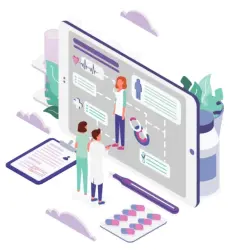Three Steps To Better Include & Engage Healthcare Workers
Appreciation and recognition for frontline healthcare workers may have been at an all-time high after the pandemic hit. Their roles were deservedly applauded as being essential not just for their organisations but for their communities as well. This highlighted importance has also resulted in greater pressure, leading to healthcare workers’ burnout. In the United Kingdom, for example, the arrival of COVID-19 severely tested Walsall Healthcare NHS Trust’s resilience. As it did much of the National Health Service (NHS) itself. The NHS funds Trusts like the Walsall Healthcare Trust to manage primary healthcare facilities, including ambulatory services, clinics, and hospitals.
COVID-19 cases surging across the country overwhelmed the Trust, which serves some 270,000 people in the Walsall area, roughly 200km north of London. The healthcare staff struggled to cope not only with the influx of sick patients but also with the challenges of managing the day-to-day operations of the institution due to sudden team dispersals. The requirement for some non-clinical staff to work from home further exacerbated the situation, causing certain services to falter.
The demand for healthcare workers has led to burnout
It’s no surprise then that the overwhelming demand for healthcare workers has led to burnout. An academic article called “Burnout Among Healthcare Workers in the COVID 19 Era” found that frontline healthcare workers involved in the management and diagnosis of COVID-19 report physical and mental exhaustion as they are exposed to life-and-death situations regularly. That’s on top of dealing with the pain of losing patients and colleagues, and the risk of infection for themselves and their families.
According to the article, this leads to the deterioration of healthcare workers’ wellbeing. There is now a relatively high prevalence of anxiety (24.94%), depression (24.83%), and sleep disorders (44.03%) among them since the pandemic started.
While more studies are needed to prove their direct correlation, some academics say healthcare workers’ burnout also indirectly impacts healthcare systems’ quality in terms of “adherence to guidelines, poor communication, medical errors, and patient outcomes and safety.” The pandemic has already led to mass resignations in different parts of the world. In the US, one in five healthcare workers have quit since the pandemic began.
Fortunately, there has been encouraging research that shows increasing healthcare workers’ engagement in their jobs helps alleviate their suffering and improve their employee experience.
Health and safety of workers and patients must be a priority
Healthcare workers must know that their health and safety, as well as their patients’, are the top priorities of hospital management. This is one of the best ways to attain genuine employee engagement, says a Harvard Business review article written by academics and healthcare leaders in Australia.
An analysis of data gathered over six years (2013-2018) from over 80 hospitals in Victoria, Australia, found that genuine employee engagement can be achieved by encouraging employees to observe, report, and fix errors or problems that place patient or staff safety in jeopardy.
Provision of mental healthcare
Caring for the well-being and health of healthcare workers must also include their mental health. Promoting mental health awareness and care among healthcare workers removes the stigma of getting help. This is also a step forward to the radical call of changing the culture of work in healthcare, by countering the stereotype of endurance which “overvalues stoicism and dismisses complaints as signs of weakness”, as noted in an academic article on burnout among healthcare workers.
This is why deploying an effective digital employee experience platform can make a difference. 64% of organisations with digitally connected frontline employees already report lower employee turnover.
LiveTiles Reach, for example, is an employee experience platform that’s deployable as a mobile-app service. Healthcare workers can easily input their insights through an app without the need for paperwork and which in turn can provide important insights to hospital management. As healthcare workers input their feedback, hospital admins can check the pulse of the workforce.
Keep communication lines open
The same platform can then be instrumental in providing relevant content and resources that support healthcare workers in dealing with mental health issues, and other concerns.
As we emphasised in “The Evolution of Frontline Workers” study, keeping communication lines open among healthcare workers can make processes more streamlined and efficient, as well as foster a stronger sense of community. Better communication will help encourage teamwork with less friction, which also enables healthcare workers to do their jobs better.
The Walsall Healthcare NHS Trust, for example, strengthened its internal communication system by replacing its old employee newsletter with an employee experience app powered via LiveTiles Reach. With 4,500 clinical and non-clinical employees spread across various departments each day, effectively delivering relevant information and guaranteeing they read it proved challenging for the facility.
“It was of paramount importance to our organisation that we found a way to reach those traditionally ‘seldom-seen’ staff groups who didn’t always have the time or computer access to receive important information. Most staff do have smartphones, however, and the Reach app allows instant and convenient two-way interaction,” Sally Evans, Director of Communications and Stakeholder Engagement, said.
Walsall actively tackled workplace disengagement of healthcare workers by deploying an employee communications platform. This approach, which involved consultation, commitment, and serious follow-through, empowered essential frontline workers and boosted their morale. With improved communication and feeling valued, these workers are better equipped to continue providing the critical care we all depend on.










